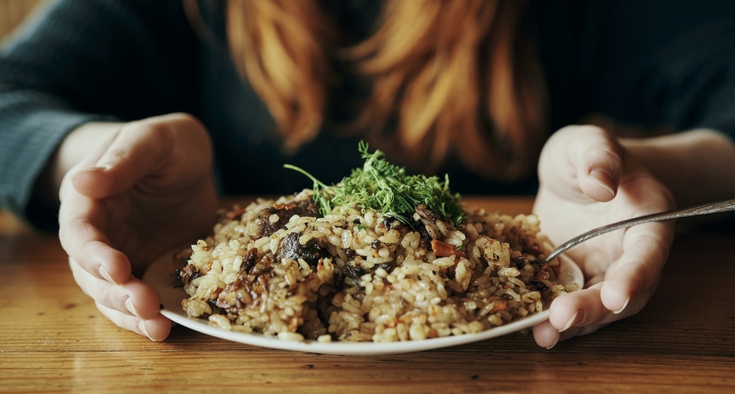The difficult symptoms of irritable bowel syndrome (IBS)and small intestinal bacterial overload (SIBO) — gas, cramping, bloating, constipation and diarrhea — can significantly affect patients’ quality of life.
But an eating strategy known as the low-FODMAP diet may help alleviate some or all of these symptoms. As many as 5% to 10% percent of the world’s population has IBS.
Despite the terminology, the low-FODMAP diet is not a weight-loss plan but a therapeutic tool designed to help people suffering from certain gastrointestinal conditions, according to Maggie Morgan, dietitian at CoreLife Novant Health - Ardmore, in Winston-Salem.
Bottom line: It’s a short-term eating plan that will help you identify specific foods that cause you the most distress, so you can build a new healthy diet that will give you less misery and more satisfaction in the long run.
Registered dietitians are ready to help.
FODMAPs (fermentable oligosaccharides, disaccharides, monosaccharides and polyolsares) are certain carbohydrates that many people with sensitive digestive tracts have trouble digesting, because of the way they interact with other foods, the bacteria in the body and the gut lining.
“By temporarily reducing the FODMAPs in a patient’s diet, we can give the digestive system and enable the gut to repair and restore itself,” Morgan said. “Then, we can better determine which foods the patient may want to reduce or avoid.”
To learn more about how the which foods are high in FODMAPs and how the plan works, we reached out to Morgan, who offered the following FODMAP primer — including helpful tips and recipes.
Who might benefit from a low-FODMAP diet?
The low-FODMAP diet was designed for people who have been diagnosed with IBS, small intestinal bacterial overload (SIBO) and other gastrointestinal conditions. The symptoms these patients live with are often exacerbated by eating.
When I work with anyone experiencing these symptoms, we first look for the most likely triggers, such as lactose in dairy products. Next — if we’re still struggling to figure out which foods are causing problems — we’ll try a low-FODMAP diet, which relieves discomfort in 86% of these patients.
We begin by eliminating all foods high in FODMAPs for a couple of weeks, until the patient’s symptoms diminish or disappear. Then, we gradually reintroduce those foods into their diet so we can spot the foods triggering their symptoms.
Can it be helpful for people who aren’t suffering from GI conditions?
When they hear the word “diet,” people often assume it will improve their health or help them lose weight. So, it’s natural that they want to try it. However, helping to manage digestive problems is the only benefit the FODMAP diet offers.
This eating plan has not been proven to improve heart health, help with weight loss or otherwise improve wellness. Also, it’s very restrictive, so people who try it on their own could miss out on important nutrients.
That’s why I only suggest the FODMAP diet to people who are experiencing GI distress, and always recommend they do so under a dietitian’s guidance.
What foods are low in FODMAPs?
While it is a restrictive diet, you can still enjoy plenty of nutritious foods, including:
- Eggs and meat.
- Many vegetables, including tomatoes, cucumbers, green beans and sweet potatoes.
- Fruits like oranges, bananas, melons, strawberries and grapes.
- Lactose-free and most plant-based milks.
- Certain cheeses, including cheddar, feta and Brie.
- Gluten-free breads, cereals and grains like rice, quinoa, polenta and oats.
What are high-FODMAP foods?
Foods high in FODMAPs include:
- Anything containing wheat, barley or rye.
- Beans and legumes, including kidney beans, lentils and chickpeas.
- Certain vegetables, including cauliflower, mushrooms and artichokes.
- Some fruits — especially those with pits or seeds, like apples, cherries, avocados and watermelon — and also dried fruits.
- Nuts, including cashews and pistachios.
- Garlic, leeks and onions.
- Dairy products made with cow, goat or sheep’s milk, including milk, yogurt and ice cream.
- Sweeteners, including high-fructose corn syrup, xylitol, sorbitol, erythritol, honey and agave.
The list of FODMAP-containing foods is daunting. But, even though every FODMAP has the potential to trigger symptoms, individual IBS patients will react to specific FODMAPs differently.
How long do patients need to stay on this plan?
The length of time depends on the individual, but usually two to six weeks. In some cases, people feel much better within a week, but it can take more than a month to reduce all the symptoms.
I always emphasize that this is a short-term elimination diet, designed to help us figure out what’s causing digestive problems. The low-FODMAP plan is not meant to be a long-term solution.
What tips do you offer patients trying the low-FODMAP diet?
- Make a detailed shopping list before you go to the grocery store, so you don’t forget any special ingredients.
- Choose different foods from the low-FODMAP categories to ensure you're getting a variety of vitamins, minerals and other nutrients.
- Consider trying Epicured if you’re struggling to create meals — they specialize exclusively in low-FODMAP meals.
- Refer to resources like cookbooks, your dietitian’s handouts and trusted websites (Morgan suggests the informational site provided by Monash University, where the FODMAP diet was first developed).
- Track your progress, note foods that cause GI distress and flag areas where you’re struggling in a food journal, so you can mention them to your dietitian or health care provider.
- Reintroduce only one food at a time, so you’ll know which ones cause problems if you experience symptoms again.
RECIPES
Low-FODMAP maple-soy glazed tempeh
- 1/4 cup pure maple syrup
- 2 tablespoons reduced-sodium soy sauce (or tamari for gluten-free)
- 1 tablespoon garlic-infused olive oil
- 1/4 teaspoon ground ginger
- Red pepper flakes, to taste (optional)
- 3 tablespoons coconut oil (or other cooking oil)
- 1 (8-ounce) package tempeh, cut into 1-inch cubes
- Optional garnish: Sliced scallions (green parts only)
In a small bowl, whisk together maple syrup, soy sauce, olive oil, ginger and optional red pepper flakes. Set aside.
Heat coconut oil in a large skillet over medium-high heat. Once hot, add tempeh pieces and cook, flipping occasionally, until sides are browned. Remove cooked tempeh from pan and place on a plate lined with a paper towel.
In the now-empty pan, add sauce and cook over medium-high heat for 30 seconds to one minute, stirring constantly, until the sauce starts to thicken. Remove from heat, add cooked tempeh and stir to coat.
Serve warm topped with optional sliced green onion tops (green parts only).
Low-FODMAP shrimp stir-fry with bell peppers
- 2 tablespoons reduced-sodium soy sauce (or tamari)
- 1 tablespoon garlic-infused olive oil
- 2 teaspoons rice vinegar
- 2 teaspoons cornstarch (mixed with 2 tablespoons cold water)
- 2 teaspoons brown sugar
- 1 tablespoon cooking oil, divided (such as avocado oil)
- 3/4 cup diced red bell pepper (about 3/4 medium)
- 1/4 cup diced green bell pepper (about 1/4 medium)
- 1 - 2 jalapeños, partially sliced in half lengthwise, optional
- 1 pound uncooked shrimp, peeled and deveined
- 2 tablespoons sliced scallion tops (green parts only)
- 1 teaspoon toasted sesame oil
- Cooked rice
In a small bowl, whisk together soy sauce, garlic-infused olive oil, rice vinegar, cornstarch mixture and brown sugar. Set aside.
Heat 2 teaspoons cooking oil in a large skillet over medium-high heat. Add peppers and chiles and cook until bell peppers are just fork-tender. Add remaining 1 teaspoon cooking oil and shrimp. Cook, stirring occasionally, until shrimp are almost completely cooked.
Stir in scallion tops (green parts only) and sauce. Bring mixture to a boil and simmer until sauce has thickened (it happens pretty quickly) and shrimp are completely cooked. Remove jalapeños. Stir sesame oil into the mixture.
Serve stir-fry warm over rice. Top with optional garnishes like a sprinkle of sesame seeds or scallion tops (green parts only).
















